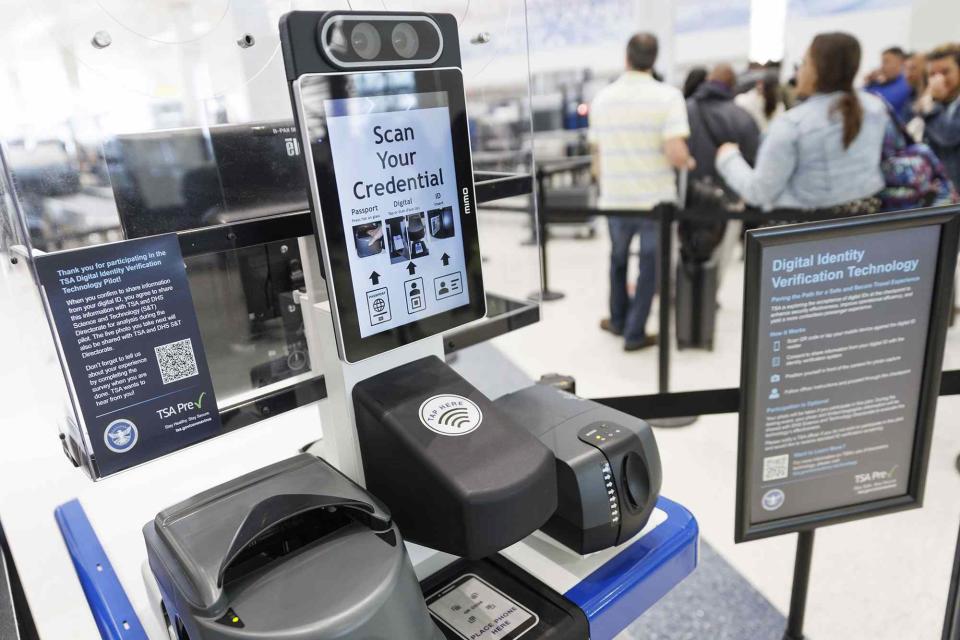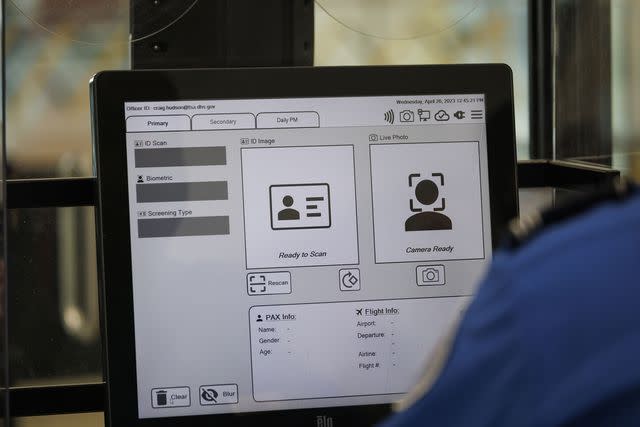Airport Security Is About to Get Way Faster Thanks to New Technology Being Used by TSA
New screening methods will allow passengers through security without showing their boarding passes or by simply taking a picture.

Ting Shen/Getty Images
A Credential Authentication Technology (CAT-2) identity verification machine at a Transportation Security Administration (TSA) security checkpoint at Baltimore-Washington Airport (BWI)Getting through airport security is probably the least fun part of traveling, but luckily the Transportation Security Administration (TSA) has been rolling out new technology to make this necessary step a bit easier.
The TSA has been introducing Credential Authentication Technology (CAT), which allows travelers to get through security without having to show a boarding pass or, in some cases, even a physical ID, the TSA detailed to Travel + Leisure. The machines come in two forms, a CAT-1 machine and a more advanced CAT-2 machine — which uses facial recognition — and can significantly speed up the security process, which is welcome news heading into a busy summer.
“Automated biometric technology can play an important role in increasing aviation security effectiveness, particularly at the airport checkpoint, by enhancing current manual identity verification procedures. Identity management is a central element to security screening,” a TSA spokesperson told T+L. “TSA is working to ensure that its biometric capabilities align with leading standards for identity assurance to strengthen vetting outcomes and identity verification. Participation is entirely voluntary.”
The machines each use biometric and digital information to identify passengers, but they do have notable differences. Their availability also varies widely by airport.
This is everything travelers need to know about the TSA’s new technology, how it works, and where to find it.
What are the CAT-1 machines?
CAT-1, which was first launched as a pilot program in 2019, scans and analyzes a passenger’s photo ID and then automatically confirms their flight details through the Secure Flight database along with their pre-screening status (like if they have TSA PreCheck) in real time. This eliminates the need for a passenger to show their boarding pass before proceeding to the screening area.
The machine can accept several different kinds of identification, including a driver's license, a passport, a permanent resident card, and more.
Passengers may no longer have to show their boarding pass at the screening stage, but the TSA notes it is still important to have it close by since travelers will need to show it at the gate in order to board a flight.

Ting Shen/Getty Images
Where are the CAT-1 machines located?
The CAT-1 units have been rolled out in about 200 airports across the country, the TSA told T+L.
What are CAT-2 machines?
Like the CAT-1 units, the CAT-2 units scan a traveler’s photo identification and match it with their flight details. But unlike the first generation of machines, the CAT-2 units are also equipped with a camera that can compare the photo ID with a real-time photo of the passenger. They are also equipped with a reader capable of scanning a state-issued digital driver’s license or digital identification card, according to the TSA.
Currently, Arizona, Colorado, and Maryland support having a state-issued ID in the Wallet section of an iPhone, according to Apple.

Ting Shen/Getty Images
What happens to your photo after it’s taken?
The new CAT-2 units are being tested under an operational assessment, the agency told T+L. Each live photo and ID photo is overwritten as soon as the next passenger’s ID is scanned. Additionally, the machine’s memory is purged when an officer logs off or turns off the machine.
Participating in the test is voluntary and if a passenger does not want their photo taken, they can opt out and let the TSA officer know.
Where are the CAT-2 machines located?
Currently, the CAT-2 units are being tested at 16 different domestic airports with plans to expand to 28 airports. The machines are currently found in Baltimore (BWI), Virginia (DCA), Atlanta (ATL), Dallas (DFW), Phoenix (PHX), Denver (DEN), Salt Lake City (SLC), San Jose (SJC), Gulfport-Biloxi and Jackson in Mississippi (GPT and JAN), Miami (MIA), Las Vegas (LAS), Los Angeles (LAX), Boston (BOS), Detroit (DTW), and Orlando (MCO).
What other technology is the TSA implementing?
The TSA has started rolling out full-size Computed Tomography (CT) x-ray systems, which are able to create 3D images of carry-on items, allowing officers to detect things like weapons, explosives, and other banned items. These new machines will also potentially speed up the security process by allowing travelers to keep more items in their carry-on bags.
For more Travel & Leisure news, make sure to sign up for our newsletter!
Read the original article on Travel & Leisure.

